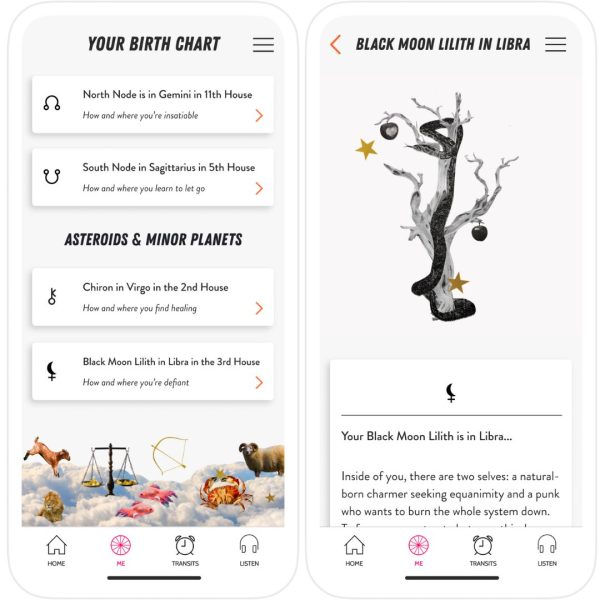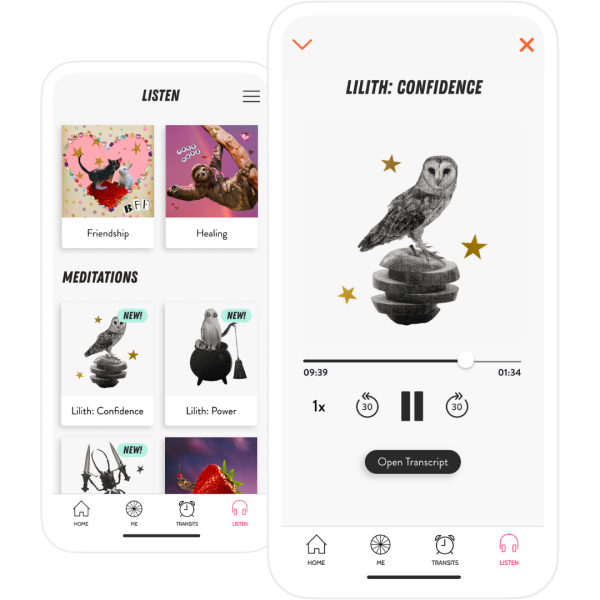The cosmic wild one Black Moon Lilith is officially in the CHANI app, so we’ve outlined everything you need to know about working with this placement.
First things first: What is Black Moon Lilith?
Black Moon Lilith is a point in space named after the mythic figure Lilith. In astrology, it represents wildness, exile, and the parts of ourselves that can be uncomfortable to witness. This archetype invites us to resist the forces within cultures of supremacy that leave us feeling alienated, atomized, and disempowered. Lilith is the protector of all those on the margins, and those who refuse to be filed down by oppressive structures.
Ways to work with Black Moon Lilith in the CHANI app

1. Learn about your natal Black Moon Lilith and how it interacts with other planets or points in your birth chart.
In the natal chart, Black Moon Lilith indicates your personal signature of defiance. Even if you consider yourself someone who generally plays by the rules, there’s likely some expectation or status quo that you chafe against. Your Black Moon Lilith placement will expose that rebellious streak, as well as areas of life where you may feel misunderstood or rejected. While these points of exile are rarely comfortable, they are what help you tap into your sovereignty and wildness. To learn about your Black Moon Lilith, go to the Me tab of the CHANI app and scroll down to Points & Minor Planets.

2. Discover if transiting Black Moon Lilith is influencing one of your natal planets or points.
When Black Moon Lilith visits a point or planet in your birth chart, it indicates a period when themes of wildness, exile, rage, or refusal are more prominent in your life. You may feel like an outsider during these moments, but also more in touch with your anger and less apologetic when it comes to refusing what’s not right for you. To learn if transiting Black Moon Lilith is impacting your natal placements, visit the Transits tab of the CHANI app.

3. Lean in to Lilith’s wisdom with our new meditations.
Because Lilith represents wildness, defiance, and dissent, we can learn a thing or two from her. These three new guided meditations from Chani Nicholas will help you plunge into the pulse of your inner feral one and unleash its wisdom. To get started, visit the Listen tab of the CHANI app.
P.S. If you don’t already have CHANI premium, you can use code LILITH30 for a free, 30-day all-access pass to the app.

Frequently asked questions about Lilith
Why is Lilith sometimes called the “first Eve”?
Lilith is an ancient archetype that predates the Hebrew Bible and even the written word. Though the first record we have of Lilith dates back to 2000 BCE in ancient Sumer, Lilith’s appearance as a decidedly less submissive Eve has captured the imaginations of many. This iconic installment of Lilith’s lore comes from the Hebrew book the Alphabet of Ben Sira, in which Lilith appears as the first wife of the biblical Adam. Anonymously written in the Middle Ages between 700 and 1000 CE, and likely intended to be provocative and satirical, this tale describes Lilith emerging from the ground — like Adam, but unlike Eve, who would be transformed into a human from Adam’s rib. In this parodic story, Lilith’s existence is not contingent upon Adam’s because she is of the same soil — and therefore his equal. Tension arises when Lilith raises this issue to her husband and refuses to lie beneath him in the conjugal act. When Adam declines to recognize and respect her authority, Lilith voluntarily exiles herself to the Red Sea and eventually gives birth to a brood of demonic babies. (You can read more about Lilith’s historical roots in this blog.)
What is Black Moon Lilith astronomically?
Black Moon Lilith (BML) isn’t a planet, an asteroid, or any kind of celestial body. It has no mass and occupies no physical space. Similar to the lunar nodes, BML is a symbolic point in our skies: the second focus within the Moon’s elliptical (or oval-shaped) orbit around Earth. This ghostly counterpart to Earth hovers closer to the lunar apogee — the farthest point from our planet in Luna’s orbit — which is pretty fitting for an archetype that dwells in life’s hinterlands.
How long does it take Black Moon Lilith to travel the zodiac?
Black Moon Lilith circles the whole zodiac in about nine years, and it moves through each sign in about nine months. The “true“ point is more erratic due to it frequently stationing retrograde and direct, however. It flashes in and out of two or three signs as it slowly progresses. Think: two steps forward, one step back. Conversely, “mean” Black Moon Lilith travels consistently (and slowly) through the signs, making its movement easier to predict.
What’s the difference between “true” and “mean” Black Moon Lilith?
Just as astrologers use true and mean calculations for the lunar nodes, there are true and mean calculations for Black Moon Lilith. The Moon’s elliptical orbit around Earth isn’t perfectly even — it wobbles. The mean calculation of Black Moon Lilith (BML) produces a location based on the average of these wobbles. If you follow the mean location of BML over time, you’ll notice that it is always moving in direct motion. In reality, BML stations retrograde about once a month, leading it to tread back and forth over the same territory for several months at a time. The true calculation captures Black Moon Lilith’s exact position at a given moment — wild sweeps back and forth and all. (This is the calculation we use in the CHANI app.)
The distance between true and mean Black Moon Lilith can vary dramatically in a natal chart, often showing up in different signs and houses. Note that one calculation is not better than the other. It’s up to the astrologer to choose which Lilith they prefer to work with.
What other versions of Lilith exist?
In modern astrology, Black Moon Lilith (BML) is the most popular astrological point named after this archetype. But there’s also an asteroid named after Lilith, as well as a dubious point in space known as Dark Moon Lilith. The asteroid Lilith — the only physical body linked to this mythic figure — orbits in the asteroid belt between Mars and Jupiter. It bears many of the same themes as Black Moon Lilith, though it’s not as commonly used.
Dark Moon Lilith, sometimes called Waldemath Lilith, emerged after controversial sightings of a mysterious second Moon orbiting the Earth. This Lilith has since been debunked, for the most part, and attributed in some sources to a smudge in the astronomer’s telescope.
Note that while the archetype of Lilith is ancient, predating even the alphabet, BML is a modern astrological concept dating to the late 20th century.
Which Lilith does the CHANI app use?
At CHANI, we use true Black Moon Lilith, which stations retrograde and/or direct about once a month, flickering back and forth over the same territory for months at a time. Because of this, you might notice this point reappearing in the Transits of the CHANI app multiple times within a given period.
Why has CHANI chosen to incorporate this archetype into the app?
We are a queer, feminist-led team, and Black Moon Lilith’s defiance, big-witch energy, and righteous rage align with our vision and values. We believe that folks using our app as a tool for self-empowerment and radical self-acceptance will benefit from the psychologically rich stories that emerge from this shadowy archetype. Furthermore, our partnership with FreeFrom — a nationwide organization dedicated to seeking economic justice and opportunity for survivors of abuse and exploitation — mirrors Black Moon Lilith’s kinship with those who are shunned, marginalized, and outside the shelter of dominant power structures. We hope that this addition to the app will help you reclaim your wildness, defiance, and desires.
Can’t find Black Moon Lilith in the app? Try closing and reopening your CHANI app. If that doesn’t work read how to update your app here.
Want to learn more about the signs in the zodiac? Click the links below.
Aries | Taurus | Gemini | Cancer | Leo | Virgo | Libra
Scorpio | Sagittarius | Capricorn | Aquarius | Pisces
Then download the CHANI app on iOS or Android for additional readings.


